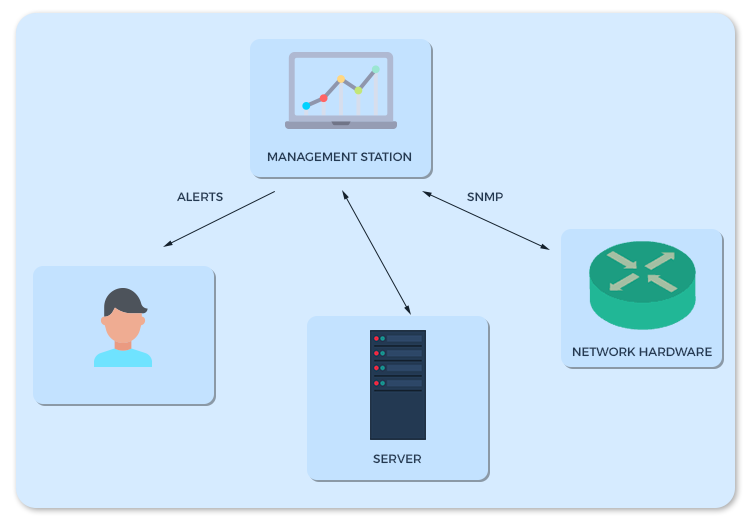You decided you need to get a better visibility over your ever-growing network. Probably you’re looking at setting up network monitoring. But then you discover you need to configure SNMP traps, and that’s when the real problems begin.
What are SNMP Traps?
SNMP Traps measure/ track alert messages sent from a distant SNMP-enabled network device to a centralised collector, which is also called the “SNMP manager”. Your gut feeling can also possibly tell you that a tool is heating, for example. (As you will recall, SNMP is one possible protocol that devices can use to communicate.)
SNMP Traps are the main medium for communication between the Agent and a Manager. They are accustomed to inform associated SNMP manager once in a while a very important event which happens at an Agent level.
Recommended: Network Traffic Monitoring : Why Network Admins Need Network Traffic Analyzer?
Types of SNMP Traps
Multiple SNMP versions exist, like v1, v2c, and v3. Each version has totally different pros & cons, and you would like to have faith in their compatibility. SNMPv3 supports encoding for security, whereas SNMPv1 is extremely easy to line up. If you have got standardized on SNMPv3, for example, you’re going to need SNMPv3 devices. Older network devices should be upgraded to newer versions. You can conjointly install a translation device to convert between SNMP versions.
Limitations of SNMP traps
Unlike alternative protocols, associate SNMP entice provides no proof that the message is received by the SNMP manager. Newer versions of SNMP embody a brand-new sort of message referred to as associate “inform” message. Which is later confirmed by the manager.
Because SNMP is asynchronous (messages square measure sent only if one thing should be reported), there’s also no automatic way to be sure a device is still online. This is an obstacle compared to polled protocols, where the central master is frequently asking each device for an update. Because SNMP is incompatible with other protocols, like Modbus or DNP3. To solve this downside, you will need associate SNMP conversion device:
OIDs and MIBs
Two crucial SNMP ideas square measure OIDs (Object Identifier) and MIBs (Management data Base). SNMP works by querying “Objects”. An object is solely one thing that we are able to gather data regarding on a network device. For instance, associated object may be responsible for Interface standing. Querying Interface standing would become a variable – the interface might be up, or down. SNMP identifies such objects via OIDs.
The Power of SNMP
This protocol is very simple, yet so powerful. This can help you manage your network seamlessly by:
- Providing Read/Write talents – as an example you may use this to reset passwords sitting remotely, also re-configure IPs
- Collecting data on what quantity measurable information is being employed
- Collecting error reports in the form of a log, which is helpful for troubleshooting and distinctive trends spotting
- Email association with alerts once your network server is low on disc space or any other threshold
- Monitor your servers’ hardware and Memory utilisation, get alerted when thresholds are met
- SMS text-messages once a tool fails
- Active polling – The station asks devices for standing each jiffy
- Passive SNMP Monitoring – devices will send an alert to a distant observation station in case of erroneous conditions
Most devices nowadays are compliant with Simple Network Management Protocol (or SNMP). SNMP could be a network device protocol that has observation tools and multiple nodes a typical language for interaction. The system relies on the agents inside network devices to provide crucial information to network managers and the monitoring tools (or NMS). An SNMP manager sends out polls to devices to inquire about their current status, and in turn network devices can then send SNMP traps when significant events occur.
Use of SNMP in NMS
If an enterprise has thousands of network devices then to check each and every device, 1-by-1 every day, if they are working or not properly is undoubtedly a hectic task. To ease this up, Network Monitoring Software leverages the poser of Simple Network Management Protocol (SNMP) to monitor all types of network devices within seconds. It also helps in getting actionable information for the user like Root Cause Analysis. With NMS users can also configure alarms and notifications for any pre- configured threshold or violation.
More Terminology
Some general SNMP words that you simply might return across:
-
- Agent: A method that monitors devices for issues and sends alerts to a observation station.
- Community Strings: Like passwords. See earlier in this article for more information.
- Get: SNMP sends a get request to device it monitors to retrieve specific data.
- Get Next: A GetNext command is employed by SNMP to urge following variable during a set – for example during a table.
- Management Station (NMS): The software configured to receive and collect information sent from SNMP agents.
- MIB: Management Information Base. See the beginning of this article for more information on MIBs.
- MIB Browser: A tool which will pull knowledge from SNMP enabled devices, helping to identify which objects respond to a query.
- Notification: Same as a “Trap”. V2c and up use the term Notifications to refer to a Trap.
- OID: Object Identifier. See the beginning of this article for more information on OIDs.
- Object: The things SNMP gathers information about. Examples are Interface status, or CPU utilization.
- Polling: An NMS will poll, or ask devices for their status regularly.
- Set: SNMP will use a collection command to vary settings on a tool.
- Trap: SNMP sends an entire, or unsolicited message sent from an agent to a management station when some important event is detected. This is the opposite of polling.
- Variable: Variables square measure the particular standing of associate object – up/down, 90% CPU used, etc.




